engine Alfa Romeo MiTo 2012 Owner handbook (in English)
[x] Cancel search | Manufacturer: ALFA ROMEO, Model Year: 2012, Model line: MiTo, Model: Alfa Romeo MiTo 2012Pages: 262, PDF Size: 6.46 MB
Page 89 of 262

88GETTING TO KNOW YOUR CAR
FUEL CUT-OFF SYSTEM
This system intervenes in the event of a collision, activating:
❍switch off of fuel supply with resultant engine switch off;
❍automatic door lock release;
❍switch on of all lights inside the car.
The intervention of the system is indicated by a message shown
on the display.
Carefully check the car for fuel leaks, for instance in the engine
compartment, below the car or near the tank area.
After a collision, turn the ignition key to STOP to avoid draining the
battery.
If, after a collision, you smell fuel or notice leaks
from the fuel system, do not reset the system to
avoid fire risk.
To reset car operation, follow this procedure:
❍turn the ignition key to MAR;
❍activate the right-hand direction indicator;
❍deactivate the right-hand direction indicator;
❍activate the left-hand direction indicator;
❍deactivate the left-hand direction indicator;
❍activate the right-hand direction indicator;
❍deactivate the right-hand direction indicator;
❍activate the left-hand direction indicator;
❍deactivate the left-hand direction indicator;
❍turn the ignition key to STOP.
Page 105 of 262
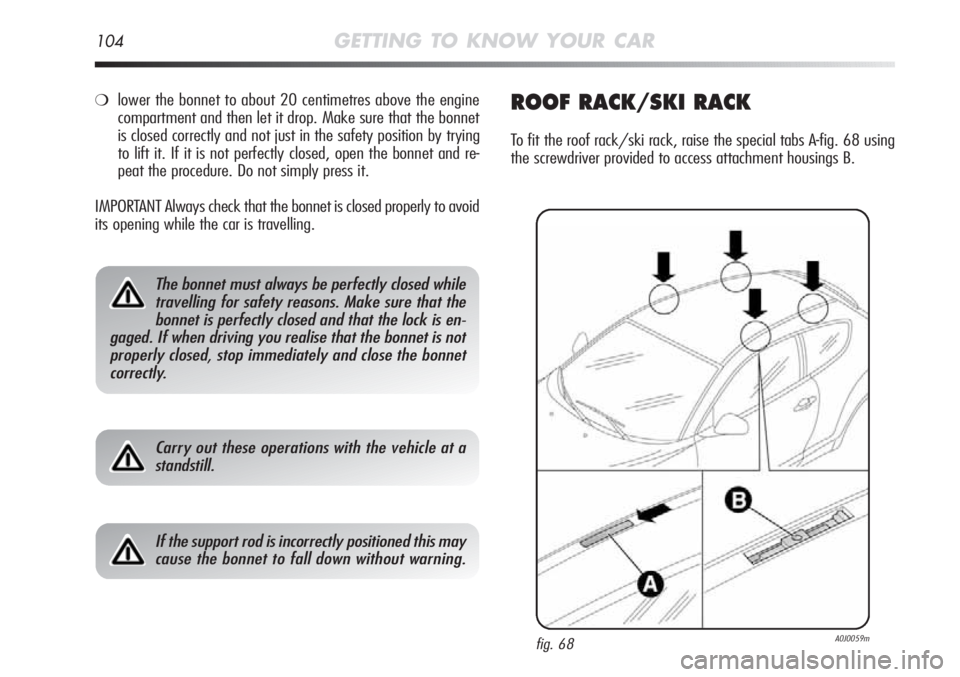
104GETTING TO KNOW YOUR CAR
❍lower the bonnet to about 20 centimetres above the engine
compartment and then let it drop. Make sure that the bonnet
is closed correctly and not just in the safety position by trying
to lift it. If it is not perfectly closed, open the bonnet and re-
peat the procedure. Do not simply press it.
IMPORTANT Always check that the bonnet is closed properly to avoid
its opening while the car is travelling.ROOF RACK/SKI RACK
To fit the roof rack/ski rack, raise the special tabs A-fig. 68 using
the screwdriver provided to access attachment housings B.
The bonnet must always be perfectly closed while
travelling for safety reasons. Make sure that the
bonnet is perfectly closed and that the lock is en-
gaged. If when driving you realise that the bonnet is not
properly closed, stop immediately and close the bonnet
correctly.
Carry out these operations with the vehicle at a
standstill.
If the support rod is incorrectly positioned this may
cause the bonnet to fall down without warning.
fig. 68A0J0059m
Page 109 of 262
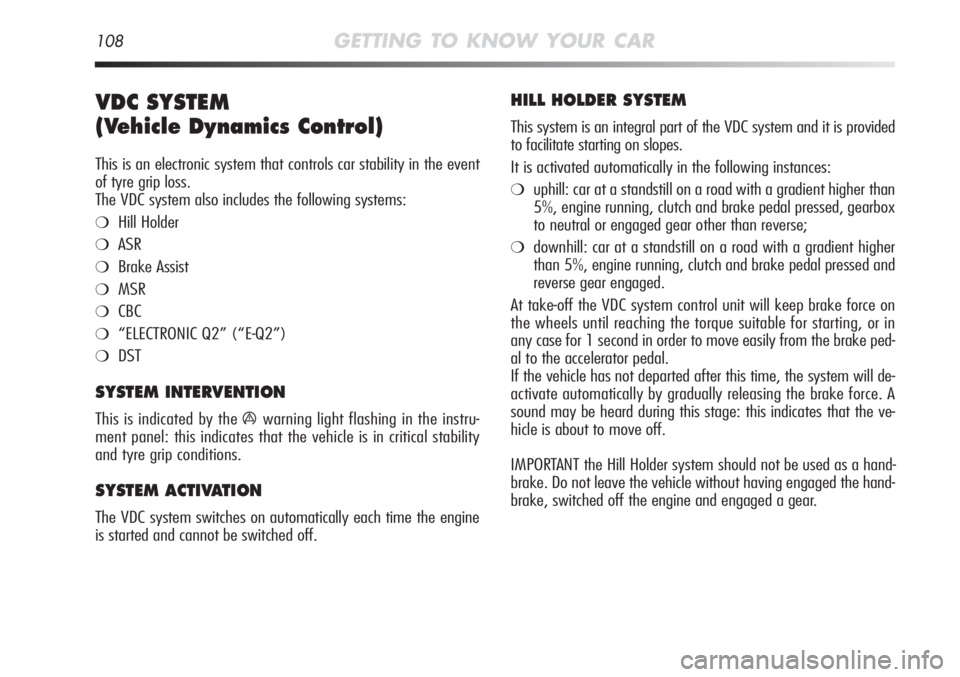
108GETTING TO KNOW YOUR CAR
VDC SYSTEM
(Vehicle Dynamics Control)
This is an electronic system that controls car stability in the event
of tyre grip loss.
The VDC system also includes the following systems:
❍Hill Holder
❍ASR
❍Brake Assist
❍MSR
❍CBC
❍“ELECTRONIC Q2” (“E-Q2”)
❍DST
SYSTEM INTERVENTION
This is indicated by the áwarning light flashing in the instru-
ment panel: this indicates that the vehicle is in critical stability
and tyre grip conditions.
SYSTEM ACTIVATION
The VDC system switches on automatically each time the engine
is started and cannot be switched off.
HILL HOLDER SYSTEM
This system is an integral part of the VDC system and it is provided
to facilitate starting on slopes.
It is activated automatically in the following instances:
❍uphill: car at a standstill on a road with a gradient higher than
5%, engine running, clutch and brake pedal pressed, gearbox
to neutral or engaged gear other than reverse;
❍downhill: car at a standstill on a road with a gradient higher
than 5%, engine running, clutch and brake pedal pressed and
reverse gear engaged.
At take-off the VDC system control unit will keep brake force on
the wheels until reaching the torque suitable for starting, or in
any case for 1 second in order to move easily from the brake ped-
al to the accelerator pedal.
If the vehicle has not departed after this time, the system will de-
activate automatically by gradually releasing the brake force. A
sound may be heard during this stage: this indicates that the ve-
hicle is about to move off.
IMPORTANT the Hill Holder system should not be used as a hand-
brake. Do not leave the vehicle without having engaged the hand-
brake, switched off the engine and engaged a gear.
Page 110 of 262

GETTING TO KNOW YOUR CAR109
1
ASR SYSTEM (AntiSlip Regulation)
This is an integral part of the VDC system. It automatically cuts in
in the event of one or both drive wheels slipping, loss of grip on
wet roads (aquaplaning) and acceleration on slippery, snowy or icy
roads etc.
According to slipping conditions, two different control systems are
activated:
❍if slipping involves both drive wheels, the ASR function inter-
venes by reducing the power transmitted by the engine;
❍if the slipping involves only one drive wheel, the ASR system
intervenes by automatically braking the wheel that is slipping.
If the spare wheel is in use the ASR system does
not work. in this case the
áwarning light will come
on in the instrument panel.
In order for the ESP and ASR systems to operate
correctly, it is essential that the tyres are of the
same brand and type on all wheels, in perfect con-
dition and, above all, of the specified type, brand and size.
If the spare wheel is used, the VDC system keeps
operating. Be aware however that the spare wheel,
being smaller than the original wheel, provides less
grip.
The performance of the VDC and ASR systems
should not encourage the driver to take unneces-
sary risks. Your driving style should always take
road conditions, visibility and traffic into account. The dri-
ver is ultimately responsible for road safety.
Page 111 of 262
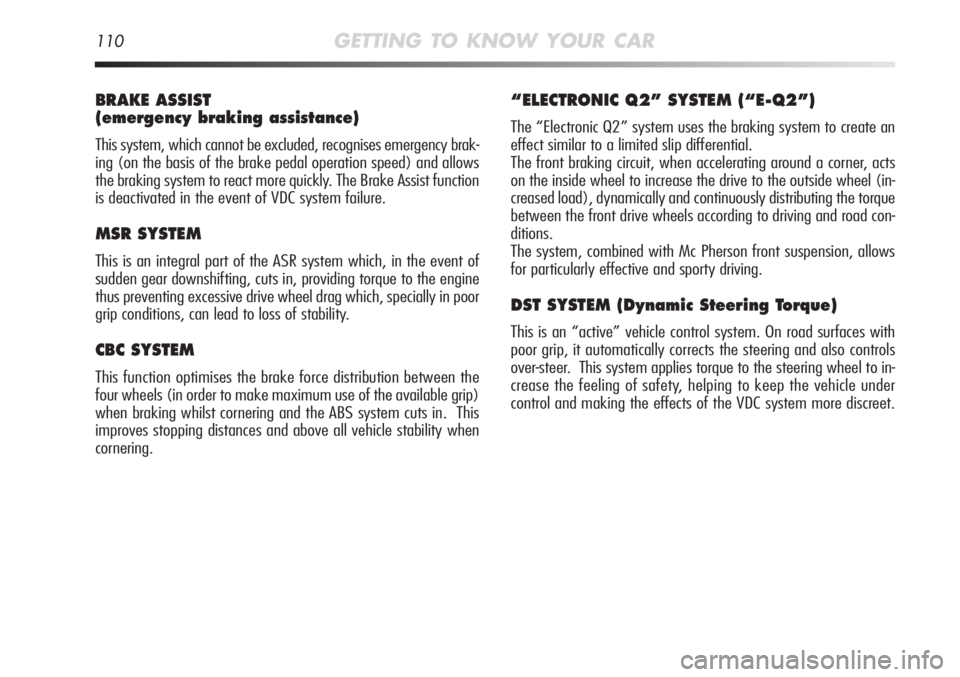
110GETTING TO KNOW YOUR CAR
BRAKE ASSIST
(emergency braking assistance)
This system, which cannot be excluded, recognises emergency brak-
ing (on the basis of the brake pedal operation speed) and allows
the braking system to react more quickly. The Brake Assist function
is deactivated in the event of VDC system failure.
MSR SYSTEM
This is an integral part of the ASR system which, in the event of
sudden gear downshifting, cuts in, providing torque to the engine
thus preventing excessive drive wheel drag which, specially in poor
grip conditions, can lead to loss of stability.
CBC SYSTEM
This function optimises the brake force distribution between the
four wheels (in order to make maximum use of the available grip)
when braking whilst cornering and the ABS system cuts in. This
improves stopping distances and above all vehicle stability when
cornering.
“ELECTRONIC Q2” SYSTEM (“E-Q2”)
The “Electronic Q2” system uses the braking system to create an
effect similar to a limited slip differential.
The front braking circuit, when accelerating around a corner, acts
on the inside wheel to increase the drive to the outside wheel (in-
creased load), dynamically and continuously distributing the torque
between the front drive wheels according to driving and road con-
ditions.
The system, combined with Mc Pherson front suspension, allows
for particularly effective and sporty driving.
DST SYSTEM (Dynamic Steering Torque)
This is an “active” vehicle control system. On road surfaces with
poor grip, it automatically corrects the steering and also controls
over-steer. This system applies torque to the steering wheel to in-
crease the feeling of safety, helping to keep the vehicle under
control and making the effects of the VDC system more discreet.
Page 112 of 262

GETTING TO KNOW YOUR CAR111
1“Alfa DNA” SYSTEM
(Dynamic vehicle control system)
(for versions/markets, where provided)
This device allows three different driving modes to be selected by
operating lever A-fig. 70 on the central tunnel.
❍d = Dynamic (sports driving mode);
❍n = Normal (normal driving mode);
❍a = All Weather (driving mode for poor grip conditions, i.e. rain
and snow on the road)
The device also acts on the dynamic vehicle control systems (en-
gine, steering, VDC system, instrument panel).
fig. 70A0J0090m
DRIVING MODES
Lever A-fig. 70 is a one-way switch, i.e. it always remains in the cen-
tral position. The selected driving mode is indicated by the corre-
sponding LED coming on in the panel and by an indication on the re-
configurable multifunctional display, as illustrated below:
A0J0227mA0J0290m
Dynamic Mode All Weather Mode
Normal Mode
When “NORMAL” mode is selected, no messages or symbols are
shown on the display.
VDCandASR: Standard calibration
Steering wheel tuning: Standard calibration
DST: Standard control of the brakes coordinated with ABS
Standard control of side acceleration
Steering wheel compensation: a slight pulse on the steer-
ing wheel tells on the driver to make a better manoeuvre
Engine: Standard response
Page 113 of 262
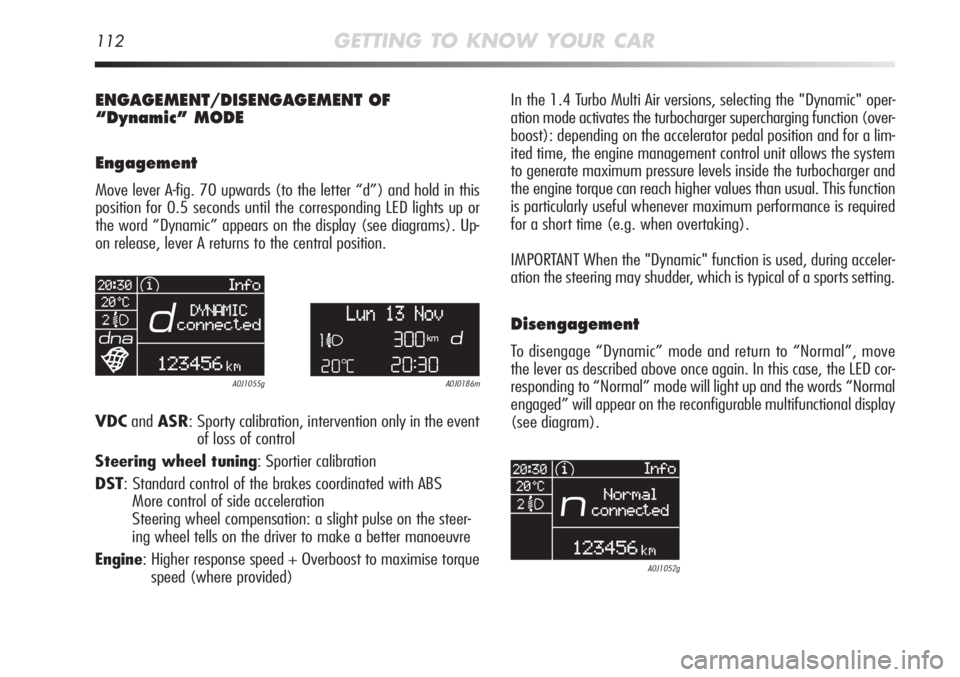
112GETTING TO KNOW YOUR CAR
ENGAGEMENT/DISENGAGEMENT OF
“Dynamic” MODE
Engagement
Move lever A-fig. 70 upwards (to the letter “d”) and hold in this
position for 0.5 seconds until the corresponding LED lights up or
the word “Dynamic” appears on the display (see diagrams). Up-
on release, lever A returns to the central position.
Disengagement
To disengage “Dynamic” mode and return to “Normal”, move
the lever as described above once again. In this case, the LED cor-
responding to “Normal” mode will light up and the words “Normal
engaged” will appear on the reconfigurable multifunctional display
(see diagram).
A0J0186mA0J1055g
A0J1052g
VDCandASR: Sporty calibration, intervention only in the event
of loss of control
Steering wheel tuning: Sportier calibration
DST: Standard control of the brakes coordinated with ABS
More control of side acceleration
Steering wheel compensation: a slight pulse on the steer-
ing wheel tells on the driver to make a better manoeuvre
Engine: Higher response speed + Overboost to maximise torque
speed (where provided)In the 1.4 Turbo Multi Air versions, selecting the "Dynamic" oper-
ation mode activates the turbocharger supercharging function (over-
boost): depending on the accelerator pedal position and for a lim-
ited time, the engine management control unit allows the system
to generate maximum pressure levels inside the turbocharger and
the engine torque can reach higher values than usual. This function
is particularly useful whenever maximum performance is required
for a short time (e.g. when overtaking).
IMPORTANT When the "Dynamic" function is used, during acceler-
ation the steering may shudder, which is typical of a sports setting.
Page 114 of 262
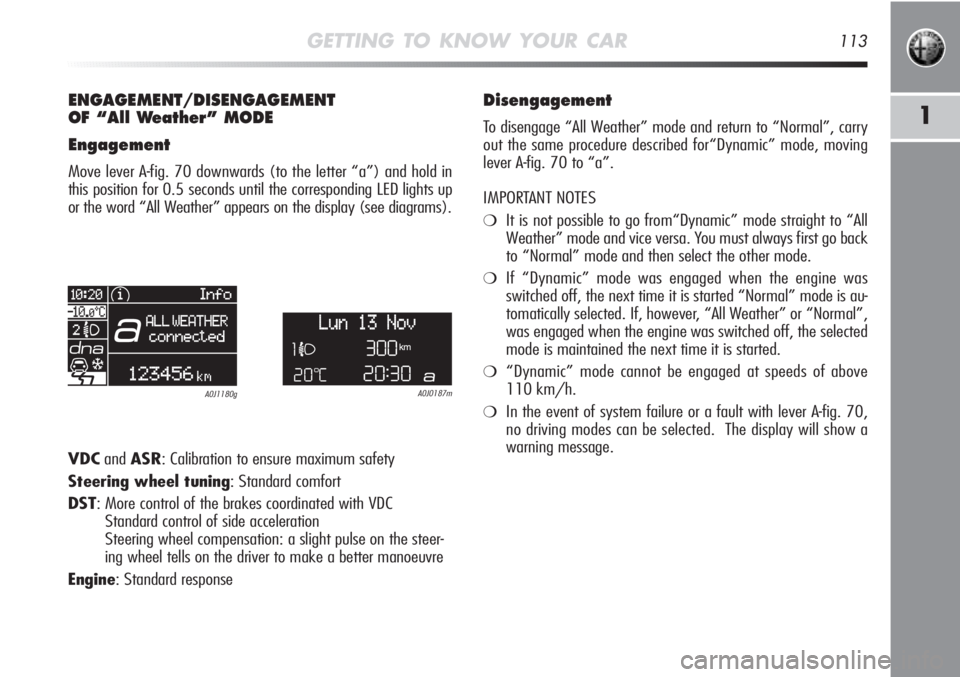
GETTING TO KNOW YOUR CAR113
1
ENGAGEMENT/DISENGAGEMENT
OF “All Weather” MODE
Engagement
Move lever A-fig. 70 downwards (to the letter “a”) and hold in
this position for 0.5 seconds until the corresponding LED lights up
or the word “All Weather” appears on the display (see diagrams).
A0J0187mA0J1180g
Disengagement
To disengage “All Weather” mode and return to “Normal”, carry
out the same procedure described for“Dynamic” mode, moving
lever A-fig. 70 to “a”.
IMPORTANT NOTES
❍It is not possible to go from“Dynamic” mode straight to “All
Weather” mode and vice versa. You must always first go back
to “Normal” mode and then select the other mode.
❍If “Dynamic” mode was engaged when the engine was
switched off, the next time it is started “Normal” mode is au-
tomatically selected. If, however, “All Weather” or “Normal”,
was engaged when the engine was switched off, the selected
mode is maintained the next time it is started.
❍“Dynamic” mode cannot be engaged at speeds of above
110 km/h.
❍In the event of system failure or a fault with lever A-fig. 70,
no driving modes can be selected. The display will show a
warning message.
VDCandASR: Calibration to ensure maximum safety
Steering wheel tuning: Standard comfort
DST: More control of the brakes coordinated with VDC
Standard control of side acceleration
Steering wheel compensation: a slight pulse on the steer-
ing wheel tells on the driver to make a better manoeuvre
Engine: Standard response
Page 115 of 262

114GETTING TO KNOW YOUR CAR
NoteThe engine automatic stop is allowed only after having run
at about 10 km/h, to prevent repeated engine stops when driving
at a very slow speed. The engine stopping is signalled by display-
ing the
Usymbol in fig. 71.
Engine re-starting mode
To restart the engine, press the clutch pedal.
SYSTEM MANUAL ACTIVATION/DEACTIVATION
To activate/deactivate the system, press the button fig. 72 on
the trim next to the steering wheel. When the system is deacti-
vated, the
Uwarning light in the instrument panel switches on.
For versions/markets, where fitted, a message plus a symbol on
the display may appear in the event of activation/deactivation of
the system.
START&STOP SYSTEM
(for versions/markets, where provided)
The Start&Stop system stops the engine automatically when the
vehicle stops and starts it again when the driver wants to resume
driving. In this way, the vehicle efficiency is increased, by reduc-
ing consumption, dangerous gas emissions and sound pollution.
The system is active every time the engine is started.
OPERATING MODE
Engine stopping mode
With stopped vehicle, the engine stops with gearbox in neutral and
released clutch pedal.
fig. 71A0J0279mfig. 72A0J0247m
Page 116 of 262
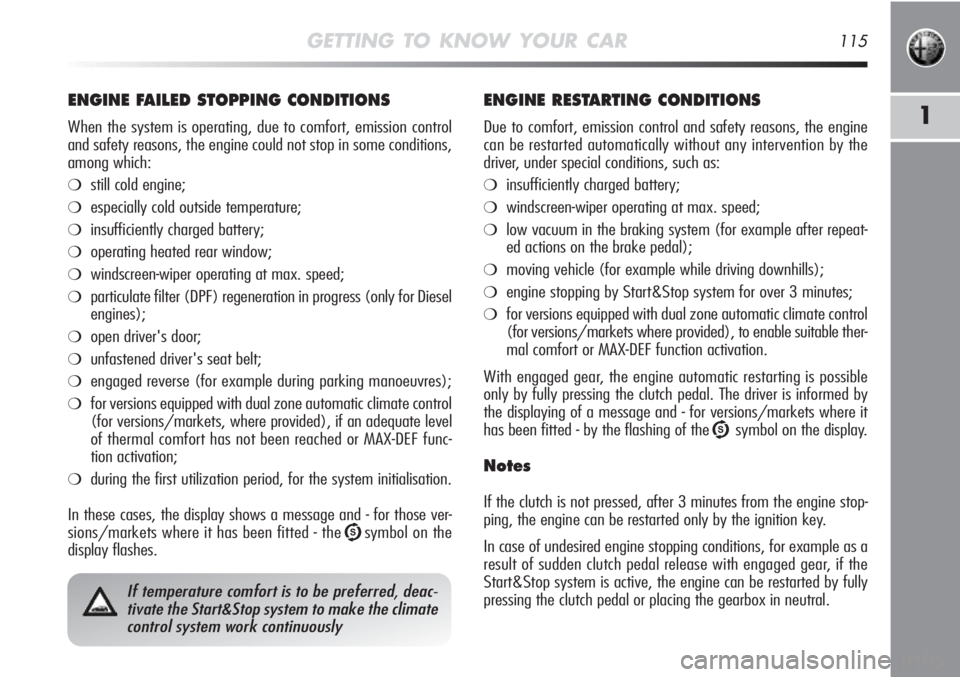
GETTING TO KNOW YOUR CAR115
1
ENGINE FAILED STOPPING CONDITIONS
When the system is operating, due to comfort, emission control
and safety reasons, the engine could not stop in some conditions,
among which:
❍still cold engine;
❍especially cold outside temperature;
❍insufficiently charged battery;
❍operating heated rear window;
❍windscreen-wiper operating at max. speed;
❍particulate filter (DPF) regeneration in progress (only for Diesel
engines);
❍open driver's door;
❍unfastened driver's seat belt;
❍engaged reverse (for example during parking manoeuvres);
❍for versions equipped with dual zone automatic climate control
(for versions/markets, where provided), if an adequate level
of thermal comfort has not been reached or MAX-DEF func-
tion activation;
❍during the first utilization period, for the system initialisation.
In these cases, the display shows a message and - for those ver-
sions/markets where it has been fitted - the
Usymbol on the
display flashes.
ENGINE RESTARTING CONDITIONS
Due to comfort, emission control and safety reasons, the engine
can be restarted automatically without any intervention by the
driver, under special conditions, such as:
❍insufficiently charged battery;
❍windscreen-wiper operating at max. speed;
❍low vacuum in the braking system (for example after repeat-
ed actions on the brake pedal);
❍moving vehicle (for example while driving downhills);
❍engine stopping by Start&Stop system for over 3 minutes;
❍for versions equipped with dual zone automatic climate control
(for versions/markets where provided), to enable suitable ther-
mal comfort or MAX-DEF function activation.
With engaged gear, the engine automatic restarting is possible
only by fully pressing the clutch pedal. The driver is informed by
the displaying of a message and - for versions/markets where it
has been fitted - by the flashing of the
Usymbol on the display.
Notes
If the clutch is not pressed, after 3 minutes from the engine stop-
ping, the engine can be restarted only by the ignition key.
In case of undesired engine stopping conditions, for example as a
result of sudden clutch pedal release with engaged gear, if the
Start&Stop system is active, the engine can be restarted by fully
pressing the clutch pedal or placing the gearbox in neutral.
If temperature comfort is to be preferred, deac-
tivate the Start&Stop system to make the climate
control system work continuously